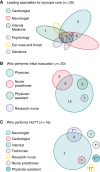A cross-sectional nationwide survey of guideline based syncope units in the Netherlands: the SU-19 score-a novel validation for best practices
- PMID: 38190741
- PMCID: PMC10793571
- DOI: 10.1093/europace/euae002
A cross-sectional nationwide survey of guideline based syncope units in the Netherlands: the SU-19 score-a novel validation for best practices
Abstract
Aims: We aimed to identify all syncope units (SUs) in the Netherlands and assess the extent to which these SUs fulfil the essential requirements outlined by the consensus statements of the European Heart Rhythm Association and the European Society of Cardiology syncope guidelines. For this, we developed the SU-19 score, a novel guideline based validation tool for best practice.
Methods and results: All outpatient clinics of cardiology, neurology, and internal medicine in the Netherlands were screened for presence of any form of structured specialized syncope care. If present, these were included as SUs and requested to complete a questionnaire regarding syncope care. We assessed all SUs using the SU-19 score regarding structure (3 points), available tests (12 points), and initial evaluation (4 points). Twenty SUs were identified in the Netherlands, both academic (5/20) and non-academic hospitals (15/20), 17/20 reported multidisciplinary involvement during initial evaluation. In 19/20, neurology, cardiology, or both were responsible for the syncope management. Non-physicians were involved performing the head-up tilt test (44%) and initial evaluation (40%). The mean SU-19 score was 18.0 ± 1.1, 45% achieved the maximum score of 19 points. Variations were observed in protocols for active standing test, carotid sinus massage, and head-up tilt test.
Conclusion: There is a network of 20 SUs in the Netherlands. Forty-five per cent fully met the SU-19 score (mean 18.0 ± 1.1). Slight variety existed in protocols for autonomic function tests. Neurology and cardiology were mostly involved in syncope management. Non-physicians play an important role in syncope care.
Keywords: Autonomic function tests; Guideline implementation; Head-up tilt test; Network; SU-19 score; Syncope units.
© The Author(s) 2024. Published by Oxford University Press on behalf of the European Society of Cardiology.
Conflict of interest statement
Conflict of interest: none declared.
Figures





References
-
- Brignole M, Moya A, de Lange FJ, Deharo JC, Elliott PM, Fanciulli Aet al. . 2018 ESC guidelines for the diagnosis and management of syncope. Eur Heart J 2018;39:1883–948. - PubMed
-
- Kenny RA, Brignole M, Dan GA, Deharo JC, van Dijk JG, Doherty Cet al. . Syncope unit: rationale and requirement—the European Heart Rhythm Association position statement endorsed by the Heart Rhythm Society. Europace 2015;17:1325–40. - PubMed
-
- Brignole M, Alboni P, Benditt D, Bergfeldt L, Blanc JJ, Bloch Thomsen PEet al. . Task force on syncope, European Society of Cardiology. Part 1. The initial evaluation of patients with syncope. Europace 2001;3:253–60. - PubMed
-
- Brignole M, Ungar A, Bartoletti A, Ponassi I, Lagi A, Mussi Cet al. . Standardized-care pathway vs. usual management of syncope patients presenting as emergencies at general hospitals. Europace 2006;8:644–50. - PubMed
MeSH terms
LinkOut - more resources
Full Text Sources
Medical
Miscellaneous

